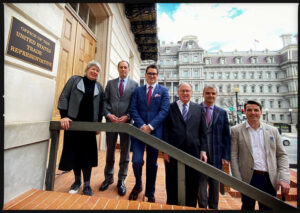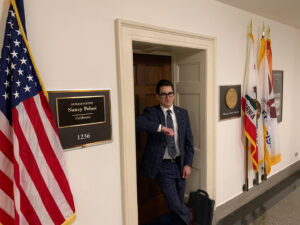TARIFFIED
LOOMING THREATS ON EUROPEAN WINES ARE CRIPPLING OUR INDUSTRY
by Erik Segelbaum
This has already been an immensely difficult year for the hospitality industry, and we’re barely through the first quarter. As it clamps down on the global economy with crushing results, COVID-19 is likely to be the nail in the coffin for thousands of wine industry-related businesses. However, that coffin was built by trade tariffs on European Union (EU) wines and the threat of more to come.

THE TALE OF TWO DISPUTES
Many people do not realize that there are two different disputes between the U.S. and the EU, both of which have led or could lead to retaliatory tariffs. First, there’s the Digital Services Tax (or DST) which was recently initiated by France. On July 24, French President Emmanuel Macron signed a bill into law to impose a 3% levy on gross revenues generated from providing two categories of digital services in France: “digital interface” services and “targeted advertising” services. The DST applies only to companies that generate, from providing the taxable services, €750 million globally and €25 million in France, according to the United States Trade Representative (USTR) website. Even though the language of these tax laws didn’t specifically indicate American companies, the provisions and revenue requirements did—to the point where the French dubbed it the GAFA tax (Google, Apple, Facebook, Amazon). The USTR then proposed a 100% tariff on Champagne specifically as a retaliatory measure. However, this Tariffied Tariffied Advanced Sommelier Erik Segelbaum, Chief Vinnovation Officer of SOMLYAY, stands in front of the office of the Speaker of the House of Representatives, Nancy Pelosi, prior to a meeting with her trade staff. T PHOTO COURTESY OF ERIK SEGELBAUM 52 { THE SOMM JOURNAL } APRIL/MAY 2020 tariff was removed from consideration after Macron and U.S. President Donald Trump agreed to table the issue until 2021.
Second, and far more significant, is the Large Civil Aircraft (LCA) dispute, commonly referred to as the Airbus dispute. It’s a complicated situation, but here are the basics: For 16 years, the U.S. has been making the case to the World Trade Organization (WTO) that the EU has been illegally subsidizing Airbus, creating an unfair trade advantage over American competitor Boeing. In late 2019, the WTO acknowledged the EU violation of global trade law and greenlit the U.S.’s imposition of a retaliatory measure. On the basis of that ruling, the U.S. initiated tariffs of 25% on all non-sparkling wine under 14% ABV in formats smaller than 2 liters from England, France, Spain, and Germany.
This tariff went into effect with almost no public knowledge and with an immediacy that blindsided the wine industry. At the time of implementation, there were thousands of containers in shipment. Importers suddenly had to scramble to come up with tens of thousands of dollars per container, decimating any hopes they had of profitability for Q4, typically their most profitable time of year. So drastic and abrupt were these tariffs that some importers had to sell vehicles, take out massive loans, lay off employees, or even shutter their businesses altogether.
As Craig Demko, Western USA Sales Manager for Compagnie Médocaine des Grands Crus, explains, “My business is 99% Bordeaux and 1% Tokaji. The October [25%] tariffs were, quite simply, devastating. From the announcement of the tariffs, my business dropped 90% through the end of the year, and I haven’t shipped a bottle yet in 2020. The uncertainty basically stopped business. I work with major customers who have just decided to wait and see and deplete inventory.”

The Tweets Heard ’Round the Wine World
In mid-January 2020, Twitter was abuzz with tweets from Trump and Macron stating that an agreement had been reached and that there would be no enforcement of either the DST or the countertariffs through the end of the year. The wine industry responded by breathing a misplaced sigh of relief. Though it was a temporary truce on a minor issue involving only one wine product, Champagne, many people thought they were celebrating the end of tariffs; they could not have been more wrong, as the 25% tariffs from the LCA were still in place.
Furthermore, the USTR had proposed expanding those tariffs to include all wine and liquor from all EU states at 100%, as well as a few hundred other items to be reviewed for adjustment every six months. One week prior to the Macron/Trump tweetathon, the USTR had closed the comment period for this action; all that was left was to wait until the February 15 deadline for the USTR’s decision.
The United States Wine Trade Alliance
Faced with this seemingly insurmountable threat to their businesses and unwilling to let everything they worked for disappear overnight, a small group of individuals began mobilizing. In a matter of weeks, the group exceeded 6,000 members (including myself), who voted on an official name, the US Wine Trade Alliance (USWTA); held an anti-tariff march on the White House; elected a board of directors, chaired by Ben Aneff, Managing Partner of Tribecca Wine Merchants; and established 501(c)(3) status. We methodically roamed the halls of government with anti-tariff messaging and spent days on end meeting with congresspeople, Senators, and their staffs on both sides of the aisle.
We found that we had the support of hundreds of government officials, many of whom took public anti-tariff stances and signed off on a letter to the USTR. Additionally, in the lead-up to the deadline for comments on the LCA expansion, we were able to assist with a social media campaign that—along with a large-scale email campaign in conjunction with the National Association of Wine Retailers (NAWR)—ensured that more than 23,000 comments were submitted to the USTR opposing increased tariff activity. The NAWR campaign also helped to send almost 30,000 letters to members of Congress.
The net result of our actions was a stay of execution of sorts. The USTR agreed not to impose additional duties or expand the tariff actions on EU wines and spirits— for now. While a huge win for not only the Members of the US Wine Trade Alliance during the “One America March” to the White House on February 9, 2020. PHOTO COURTESY OF ERIK SEGELBAUM { SOMMjournal.com } 53 industry but the broader American public, the decision is up for review in August 2020, meaning the threat of 100% tariffs still looms large on the horizon.

Tariffs Cost American Jobs
When the 21st Amendment repealed Prohibition, it also established the three-tier distribution system for alcoholic beverages while giving individual states governing authority over the sale and regulation of these products. As a result, there are tens of thousands of people employed along the wine supply chain between Europe and the U.S.
By law, European wines must be brought to the U.S. through an importer, which must then sell to a distributor. The distributors then sell to the intermediary, be it on- or off-premise, which then sells to the end user, or consumer. The reason that tariffs are problematic with respect to the alcohol industry is that their costs are borne by the importer, which, by law, is an American business. This differs from industries in which foreign entities can own and profit from all tiers of distribution from export to retail. For example, a European fashion house can own the export company, import company, distributor, and retail outlets, which can all funnel revenue back to Europe. With respect to alcohol, approximately 85 cents of every dollar spent on EU wines and spirits is revenue that is generated by domestic businesses and that stays within the U.S., according to the American Association of Wine Economists, whose data also shows that EU wine imports to the U.S. accounted for nearly $11 billion in 2015. Since then, we’ve been on an upward trend, with estimates suggesting that the (pre-tariff) 2019 figures could approach $20 billion. That would mean $20 billion of potential lost revenue and profit to American businesses in 2020 (as estimated before the COVID-19 pandemic brought the industry nearly to a halt).
It also bears mentioning that there are over 6,500 distributors and importers along the distribution pathway and tens of thousands of on- and off-premise establishments—all of which have been or will be impacted by tariffs. These businesses employ thousands of people and pay all sorts of operating and payroll taxes. Furthermore, sales tax alone (on the aforementioned $20 billion projections) would account for nearly $1.8 billion of potential loss from state and federal coffers—money that would typically be used to fund infrastructure, health care, and educational programs.
In short, the problem is not that the wealthy will have to pay more for their luxury goods. This is about the warehouse workers, truck drivers, administrative staffers, bussers, dishwashers, hosts, servers, cooks, sommeliers, retail employees, and more who will lose their jobs when businesses shutter due to their inability to absorb the increased costs of tariffs.
But Isn’t This Good for American Wines?
Put simply, the answer is no. In fact, most U.S. wine organizations, such as the California-based Wine Institute (representing California’s wineries and grape growers), strongly oppose the tariffs on the grounds that they will destroy domestic business as well. Many distributors keep their lights on through their European portfolios, and if they shutter, American wineries lose their path to market. Meanwhile, the threat of counter-tariffs can dry up the export market overnight. What’s more, America simply does not have the capacity to produce the amount of wine needed to fill the void, nor can domestic wines be produced as inexpensively due to elevated land, labor, and production costs.
Because the costs are paid by Americans, these tariffs only serve to hurt America. EU wine is a finite resource that cannot increase much if at all due to appellation law, which means that the demand for EU wines far exceeds supply; it’s only thanks to decades-old relationships that the U.S. imports as much EU wine as it does. Even in a tariff-free environment, many EU producers could double their price and sell to China and other trade competitors. Now that the U.S. is becoming an unreliable trade partner, they are indeed sending their products to other countries and making more money because of it. The bottom line is that the tariffs not only hurt the U.S. and not the EU, they also reward our biggest trade competitors.
This is not a partisan issue, it’s an American issue—and there’s something you can do about it. Write to your representatives in Congress to express your concerns that these tariffs hurt Americans and cost American jobs, and ask them to stand publicly in opposition. Contact the USTR and urge them to remove wine and spirits from the tariff carousel for at least the next year to give Americans a chance to rebound financially from the COVID-19 pandemic. And, finally, join the USWTA at uswinetradealliance.org. These are all vital steps toward making your voice heard and protecting our industry in this time of great uncertainty.
